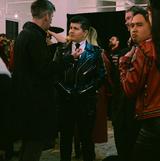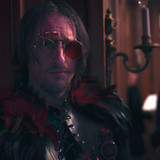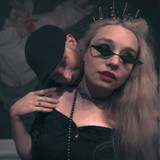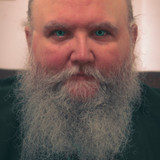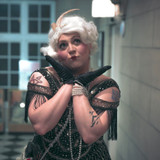A Walk on the Wild Side
.
.
One of my favorite aspects of the “Horror” genre and all the creatures that are part of it, is the way that it’s been universally inclusive, while being able to tackle social concerns that might not be allowed in other genres for whatever reason. Something about the fantastical nature of the terrifying, supernatural and bizarre allows the open representation and embrace of natures that aren’t considered the status quo.
One of the staples of classical horror has always been the werewolf, and lycanthropy in general. Science and psychiatry has attempted to explain this away through historical traces of ergot poisoning, a fungus that occurs on rye seeds and bread. Rife with allegories on having to hide ones true self, being able to accept that you aren’t what you appear on the outside, and the fear of the status quo against someone who is different. It serves as no surprise that werewolves in general can and have been easily associated with the LGBTQIA+ community. Werewolves and other lycanthropes have long since embodied the pure essence of queer. A form that’s changing and evolving, even among other “monsters” of the time.
Within the World of Darkness werewolves are separated into Tribes, each with their own unique personalities, wants, desires, and stereotypes. The most obvious example of inclusion here are the Black Fury tribe, who originally would accept no members that were assigned male at birth unless they were those born from the “sin” of love between two werewolves. Women dominate this tribe and its leadership. Bisexuality and lesbianism are seen as almost accepted, and often they are compared to historical Amazons or Baccantes of Ancient Greece. Men were often looked at as a means to an end, with actual love between two members of the tribe generally occurring between women. Though it’s hard to assume the original intent of their creation, it can definitely be implied that it was a move to bring power to otherwise marginalized females at the time. Feminism in the world was pushing forward, as were civil rights movements for the Community. As the setting has evolved, and as the understanding of gender, expression, and identity have also evolved, so too have the Black Furies changed. Now the tribe espouses those who are ‘female at heart’ or with the ‘heart of a woman’, displaying an acknowledgement and acceptance of differences in gender identity and expression. They also became a tribe willing to accept trans women as equal in footing to those assigned female at birth. It’s difficult to narrow down specific NPCs that are strongly implied as having been homosexual or otherwise queer, but among them for the Black Furies, Electra Shieldmaiden definitely stands out to me. Despite being from an orthodox greek upbringing she is a ferocious fighter, and is generally among the front lines when it comes to the fights in the Amazon. The Amazon’s of Diana stand out where I’ve seen the majority of player characters who weren’t heterosexual being played, and for a long time I played a Black Fury ahroun member of this camp that was strongly bisexual. She was married only because she needed a man to be able to carry on a bloodline, but close relationships and loves were always female. It was the easiest way to avoid breaking the litany after all (Garou shall not Mate with Garou).
Standing proudly in their acceptance of the individual regardless of who they may love, are the Children of Gaia. Their origin story is less clear, but the intent remains the same throughout all the revisions. They are the tribe formed of those who have been refused, or rejected by the “normal” tribes for whatever reason. Often stereotyped as hippies, they hold fast to the beliefs that love is not dangerous and should be freely shared regardless of who it is with. They accept all types of sexual orientation and gender identities. Another refreshing breath of acceptance in a world of personal horror. Among their ranks there is Lore-Speaker Gron, from the times of the Impergium, an intersex ahroun who survived many assassination attempts and triumphed using their wits and cunning over their brawn. Among my experiences playing werewolves in LARPs, my Child of Gaia was definitely the most interesting one. Polyamarous, pansexual, a homid Galliard who eventually rose to be the Alpha of the sept. Love does not see the boundaries of gender identity was one of her core beliefs, coupled with that everyone, even the metis, were worthy and deserving of love. She definitely had her share of enemies, and while I expected there to be the typical shunning because of being the “hippy” it was definitely eye opening to see people who seemed to be vehemently opposed to the idea of a polyamorous werewolf. Of all the LARPs I’ve taken part in however, werewolf has always tended to lean more towards being more accepting of queer characters than any of the other supernatural splats save perhaps Changeling.
The strong ties between the community and the genre stretches out into Hollywood film and television, staying not only within the paradigm of lycanthropy but also reaching out into other supernatural elements. In the late 90’s Buffy the Vampire Slayer stormed onto the television screen, and while it dealt mainly with vampires, other supernaturals made their appearances. It was only a matter of time until we were able to see a blossoming beautiful relationship between Willow and Tara, two young witches in love. While their relationship wasn’t perfect it was absolutely empowering to see a positive lesbian relationship on mainstream television. Buffy also allegorically holds a high regard to representing the struggle of being queer. A slayer has no say in being a slayer, they are born with this expectation of who they will become, and largely have to hide their real identity from their families for fear of what could happen if the information was public. She finds safety in a tight knit group of other “outcasts” who know her secret and yet still love and support her. A strong stance to take in modern television when society still wasn’t nearly as accepting as it should have been.
In 2016 Hulu brought onto the screen a series called Shadowhunters, based on the largely popular YA series The Mortal Instruments. Shadowhunters are human-angel hybrids given the power to hunt demons. Here we get the thrill of engaging with a homosexual Shadowhunter named Alec and his boyfriend, a bisexual warlock named Magnus. Breaking with what seems to be a “safe” road of showing typically female queer relationships, this series lets us follow along with queer males in a positive manner. Though admittedly, while not clear in what type of supernatural they are, my personally favorite representation of a healthy homosexual relationship is in the Old Guard (Netflix 2020). With no understanding of why or how they are chosen, a group of functionally immortal humans band together to try and make the world a better place. Among them, two men, Joe and Nicky, are clearly in a romantic relationship with each other. When they are mocked, Joe makes one of the best monologues heard in a long time, defining and proclaiming their immortal love and relationship, despite having been from mortally warring nations previously. If you haven’t had a chance to take it in, the Old Guard should absolutely be on your watch list.
Check out our Pride merch- 20% of revenue goes to the Trevor Project, dedicated to to end suicide among LGBTQ young people.



